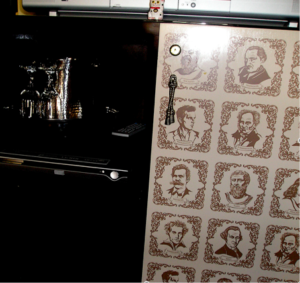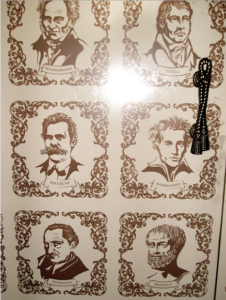Hello, dear readers —
You are all especially dear to me today, my friends: so many of you have been writing in for pre-conference advice over the weekend that I feel as though the first thing I should do at the conference is spike the water supply with Rescue Remedy! Please do understand that thousands of people read this blog, so I cannot possibly read every potential pitch that is sent in. I do want to help you all as much as I can, however.
For starters, everybody, please: take a nice, deep breath. Repeat often.
I understand that getting ready to pitch, particularly for the first time, is stressful, but please do remember, agents and editors are only people, albeit people with power over whether your work gets published. They are not going to laugh at you, they are not going to make fun of your dreams, and they are not going to throw things at you.
How do I know this? The PNWA honestly does go to some trouble to make sure the publishing types they ask are nice to its members. (So if anyone, be it agent, editor, or speaker, is mean to you: please let me or one of the many fine conference volunteers know ASAP. Or write about it on the conference feedback form.) The agents and editors really are coming to the conference to find fresh new voices, so they are as eager to hear about your book as you are to tell them.
Well, okay, ALMOST as eager.
Generally speaking, they will be polite to you if you are polite to them, so try not to build them up in your mind as either evil demons bent on your destruction or angels who are going to hear your pitch, cry out in incredulous joy, and sweep your book off to Manhattan to be published tomorrow. In order to be successful in your pitch, all you have to do is convince them that your book’s story or argument is gripping enough to deserve their reading the first chapter.
Make this your goal, not convincing them that your book is going to sell as well as THE DA VINCI CODE or Bill Clinton’s autobiography. Approach the task in small, bite-sized pieces: tell the nice person in front of you your name, your book’s category, its title, its target market, and what it is about, briefly. Identify a few selling points, and have an answer ready about why it will appeal to its target market. And really, that’s all you have to do.
Breathing a little easier now?
Practice will make you calmer at the crucial moment, I promise you, so please, make friends with lots of other writers at the conference and pitch to them. Listen to other people’s pitches; over the years, I have learned a TREMENDOUS amount about what does and doesn’t work this way. (It’s also the easiest way in the world to meet terrific people who share your passions: literally all you have to say to start a conversation at a writer’s conference is, “So, what do you write?”)
And please, PLEASE take advantage of the Pitch Practicing Palace at the conference, where yours truly and four other excellent, already-agented writers will be ready and eager to hear you run through your pitch (ideally, BEFORE you give it in a meeting) and give you feedback on how to make it better. We have all been in your shoes, have all pitched our writing successfully, and have years of experience in knowing what makes a pitch work. I promise you, we’re all very nice people, and we all truly do want to help you present your book to the agents and editors in the best possible light.
When, I hear you asking, can conference registrants avail themselves of this FREE service? Why, Thursday, July 13th, 3 pm to 5 pm; Friday, July 14th (Bastille Day!), 7:30 am to 5:30 pm, and Saturday, July 15th, 7:30 am to 3 pm. We’re anticipating being pretty swamped beginning Friday afternoon (the actual pitch appointments begin at 1:30), so please, plan to visit us early (and WELL before your first appointment, please) to sign up for a time to practice with the pros!
And, of course, if you just want to meet me and ask questions I haven’t yet answered on the blog, that will be the place to find me for pretty much all of the daytime hours of the conference. But again, before the pitch appointments start is probably your best bet for chatting time.
Now, on to other business: sharp-eyed reader Brenda sent me a charming message this morning, pointing out that I had used the term PLATFORM last week without remembering to define it. My apologies; I spend so much time steeped in industry jargon that I sometimes forget to translate. (For a glossary of similar industry terms, please see my archived posts for September 23 — 28). Platform is a term that all of you, especially those of you who will be pitching NF, should know before the conference:
PLATFORM, n.: For nonfiction, the array of credentials, expertise, and life experience that qualifies you as an expert on the topic of your book. Generally, the first thing an editor will want to know about a prospective NF author.
Put another way, platform is the industry term for why anyone should trust a NF author enough to want to read her book. The platform need not consist of educational credentials or work experience — but by all means, if you happen to be a former Secretary of State or NBA superstar, do mention it. The platform is ANY reason, or collection of reasons, that you are the best person in the universe to write this particular book.
For example, in the case of my memoir, I have written about a very well-known science fiction writer, as others have before me; if you are not a SF aficionado, the films BLADE RUNNER, MINORITY REPORT, TOTAL RECALL, and the recently-released A SCANNER DARKLY were all based upon his work. (The book, should you be curious, is A FAMILY DARKLY: LOVE, LOSS, AND THE FINAL PASSIONS OF PHILIP K. DICK, as of the last time I checked ranked in the 26,000s on Amazon! Catch me if I faint. PNWA members, please remember, if you should be kind enough to want to buy it at the SIGNIFICANT discount Amazon is giving for preorders, if you go through the PNWA member site to get to Amazon, the organization gets a piece of the action. I just mention.) The authors of the already existing PKD biographies had platforms that were pretty straightforwardly professional: they had done extensive research, conducted interviews with people who knew the man, and in some cases, even had in-person interactions with Philip. My platform was considerably more personal: Philip was married to my mother for 8 years; from the ages of 8 to 15, he was my primary adult confidante. Because of this, we saw sides of each other that we showed no one else.
Why is this a credible platform, in the eyes of the industry? I have direct personal experience that makes me an unusually-situated narrator; the fact that I was so young during our years of contact, and going through major changes myself, adds an additional interest. Furthermore, through my parents and a lifetime spent in contact with Philip and his friends, I have interview sources another writer could not.
See my point here? The fact that I have a Ph.D. is actually irrelevant to my platform for this book. It’s not why I am literally the only person on earth who could have written this memoir — and THAT’s what’s essential for a compelling platform.
All of you NF writers out there: prepared to answer questions about your platform BEFORE you walk into your meetings with agents and editors. Even my fellow memoirists — yes, I know, it seems self-evident that a memoirist would be an expert on the story he tells, because it’s his own life. (As someone whose memoir has been plagued by legal threats over whether I had the right to tell the story of my own life or not, I am here to tell you: not everyone may agree with you that your personal experience is yours to discuss in print.)
But a memoir is always about something in addition to the life story of its author, and your platform should include some reference to why you are qualified to write about that other subject matter. If your childhood memoir deals with your love affair with trains, for instance, make sure you include the fact that you spent 17 years of your life flat on your stomach, going “woo, woo” at a dizzying array of model trains.
For what it’s worth, novels are generally about something other than the beauty of their writing, too. They have settings; characters have professions. For instance, the novel I am writing now is set at Harvard, where I got my undergraduate degree: think that is going to make my novel more credible in the eyes of the industry? You bet.
Technically, a novelist doesn’t NEED a platform (and to set your mind at ease, Brenda: neither does any other non-NF writer), but it’s always a nice touch if a fiction writer can mention a platform plank or two. (See my July 2 post on selling points for tips.)
My, I got carried away there, didn’t I? My real goal for today was to fill you in on an agent and editor added to the conference list after my April 26 — May 26 series on those who were coming. So I took a gander at the standard industry databases (usual caveats about their accuracy), to see what I could tell you about them.
Kate McKean, the lately-added agent, until fairly recently was with Dystel & Goderich, the agency that represents me (and who is sending sterling agent Lauren Abramo to this year’s conference). So recently, in fact, that Ms. McKean is still listed on Preditors and Editors (always a site worth checking) as being at DGLM. Now, Ms. McKean is with the Howard Morhaim Literary Agency. Let’s see what she had to say for herself in the blurb she submitted to the PNWA:
“After earning a Masters in Fiction Writing from the University of Southern Mississippi, Kate McKean (Agent) set out to start her publishing career as an agent in New York City… Her interests lie in contemporary women’s fiction, paranormal romance, urban fantasy, literary fiction, narrative non-fiction, sports related books, pop culture, and health and wellness. She is primarily interested in people and the strange, wonderful, surprising, and heartbreaking stories they tell. She’s most happy immersed in a good book, especially Fitzgerald, Faulkner, Carver, and Chabon.
“Howard Morhaim Literary Agency represents a wide variety of clients in a number of areas including science fiction/fantasy, history, politics, literary fiction, science, business, and journalism. Some of the agency’s notable clients include Stephen R. Donaldson, author of the Thomas Covenant fantasy series, Joanne Harris, international best selling author of CHOCOLAT, and international best-selling author Arturo Perez-Reverte, just to name a few.”
Setting aside the glee with which the immortal phrase “she’s primarily interested in people” (as opposed to, say, those agents who eschew any topics relating to human endeavor?) raises in my bosom, what can we learn from this? What excites me most is that she has an MFA in writing — and from a good program, at that (and one that would render her NOT being a Faulkner fan surprising). This is a writer, my friends, and although it pains me to say it, writers understand other writers better than other people understand them.
In the past two years, while still at DGLM, she sold a book for middle readers, Suzanne Selfor’s debut CURSE OF THE MERFOLK, “about what happens when a brother and sister find a baby mermaid and the trouble that ensues.” (Little, Brown Children’s, 2006, in a two-book deal), and a three-book deal for women’s fiction writer Richelle K. Mead, including SUCCUBUS BLUES, “about a modern-day succubus living in Seattle who prefers her normal life to the alluring, shape-shifting life of legend and myth.” (Kensington, 2005) She’s probably had other sales as well, but if so, they were not listed in the standard industry databases.
As I said in my earlier agent and editor series (April 26 — May 26), an agent who is trying to build her client list may be a tremendously good bet for a previously unpublished writer. She may well be open to a broader array of voices, as well as more queries, than someone with an established list.
What gives me a bit of pause, though, is the fact that the Howard Morhaim Literary Agency listed itself in the latest GUIDE TO LITERARY AGENTS as not accepting new clients. As, I notice, they did in the 2003 guide of the same name. Since the agency does not have a website, I was not able to confirm or deny this preference. I wouldn’t panic, though, since they are in fact sending an agent to the conference: this might just mean that their staff is not fond of filling out the questionnaires the guide sends every year, or it might mean that they are very, very selective indeed.
I do, however, have ways of finding out who is represented by the agency, beyond the limited list above, which may help you determine if this would be the agency for you. Here are the names and titles I was able to turn up, in alpha order (hey, I’m a librarian’s daughter): K.J. Bishop (THE ETCHED CITY, Bantam Spectra), Robert Cowley (WHAT IFS IN AMERICAN HISTORY, Putnam), Robert Crease (TEN GREAT EQUATIONS THAT SHAPE THE WORLD, Norton), Stephen R. Donaldson (THE CHRONICLES OF THOMAS COVENANT, among hosts of others, Putnam), Christopher Fowler (FULL DARK HOUSE), David Gemmell (THE SWORDS OF NIGHT AND DAY, Ballentine), Richard Grant (ANOTHER GREEN WORLD, Knopf), Joanne Harris (JIGS AND REELS, Harper), Mira Kirshenbaum (THE EMOTIONAL ENERGY FACTOR, Delta), Stan Nicholls (THE RIGHTEOUS BLADE, Morrow; my, what a lot of sword imagery we have going on at this agency, eh?), Arturo Perez-Reverte, David Rosenberg, David Sandmire, MD (THE SAVE YOUR LIFE TESTS: LIFESAVING MEDICAL TESTS YOUR DOCTOR WON’T ORDER UNLESS YOU INSIST, Rodale), Michael Stackpole (CARTOMANCY, Bantam), Barry Strauss (THE TROJAN WAR, Simon & Schuster), Lisa Tuttle (THE MYSTERIES, Bantam Spectra), Jeff VanderMeer, (CITY OF SAINTS AND MADMEN, Bantam), Barbara Victor (TERRORISM; ABSENCE OF PAIN; MISPLACED LIVES; FRIENDS, LOVERS, ENEMIES; CORIANDER; HANAN ASHRAWI, PEACE IN THE MIDDLE EAST; GETTING AWAY WITH MURDER; THE LADY, THE LIFE OF ANG SAN SUU KYI; THE MATIGNON OF JOSPIN; GODDESS, INSIDE MADONNA; ARMY OF ROSES; THE LAST CRUSADE, Harper Collins), Ann Volkwein (ARTHUR AVENUE COOKBOOK, Reganbooks).
So if you have your heart set on Bantam, I would advise making friends with Ms. McKean as soon as possible: her agency apparently has some excellent connections there.
I had hoped to get to the new editor today, but I see that I am already running very, very long. I shall post about her tomorrow. In the meantime, keep remembering to breathe, conference-goers, and everybody, keep up the good work!
– Anne Mini


